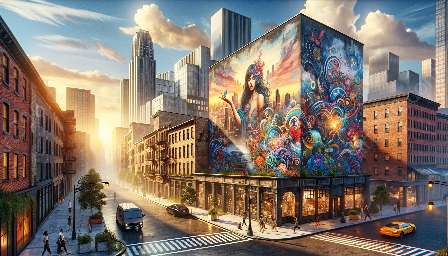Street art and graffiti have become integral parts of urban culture, providing a platform for artistic expression that challenges traditional notions of art and public space. Despite their similarities, street art and graffiti evoke different public perceptions and receptions. Understanding these differences is essential to appreciating their impact on society.
Street Art: Transforming Urban Spaces
Street art, often characterized by visually captivating murals and thought-provoking installations, has gained widespread appreciation for its ability to transform urban spaces. Artists use public walls and structures as their canvas, creating engaging pieces that reflect social and political commentary, cultural diversity, and artistic innovation.
Public Reception of Street Art
The public reception of street art is generally positive, as it enhances the visual appeal of communities and fosters a sense of creativity and vibrancy. Communities often embrace street art as a form of public art that adds personality and character to their surroundings. In many cases, local authorities and businesses collaborate with street artists to commission large-scale murals and installations, further blurring the lines between traditional art and public space.
Public Perceptions of Street Art vs. Graffiti
Street art is often viewed as an acceptable and even desirable form of artistic expression, as it aligns with contemporary ideas of urban beautification and cultural enrichment. The public perceives street art as a legitimate art form that contributes to the visual landscape and narrative of a city.
Graffiti: A Complex Artistic Expression
Graffiti, on the other hand, is commonly associated with illicit tagging, vandalism, and urban decay. While graffiti techniques may share similarities with street art, its reception and public perceptions differ significantly due to its historical association with delinquency and defacement of public property.
Public Reception of Graffiti
Graffiti often faces negative public reception due to its link to vandalism and illicit behavior. Many individuals view graffiti as a blight on urban environments, contributing to a sense of disorder and neglect. Public authorities frequently invest in graffiti removal programs to combat its presence in public spaces, leading to an ongoing debate on the artistic merit versus societal impact of graffiti.
Public Perceptions of Graffiti vs. Street Art
Public perceptions of graffiti often contrast sharply with those of street art, with graffiti being stigmatized as a form of criminal activity and visual pollution. However, contemporary discussions around graffiti have emphasized its potential as a legitimate art form when executed with intent and purpose, sparking conversations around its role in urban expression and the boundaries of artistic freedom.
Navigating Urban Culture: Embracing Artistic Diversity
The coexistence of street art and graffiti underscores the diversity and dynamism of urban culture. As public perceptions and reception continue to evolve, it is essential to recognize the nuanced intersections of artistic expression and social context. By engaging in open dialogue and promoting inclusive approaches to urban art, communities can celebrate the transformative power of street art and challenge preconceived notions of graffiti, fostering a more nuanced understanding of these distinctive art forms.

